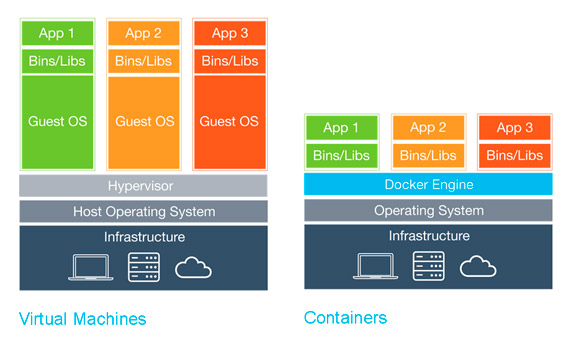6 Key Factors to Understanding Technology Containers

Technology Containerization has emerged as the IT industry’s trending buzzword for its ability to speed up application delivery mechanism! Yes, majority of IT firms are in the run for continuous integration and continuous delivery cycles to gain a competitive edge. And, the answer they found in this journey is ‘Technology/IT Containerization’. Containerization, as a lightweight alternative to traditional Virtual Machines (VMs), brings in a new approach to deal with applications, making them distributed, portable and efficient.
Productivity is not just the only advantage that Containerization offers, as it also helps reduce the concerns about the infrastructure when it comes to the delivery of applications on a faster scale. This makes containerization one of the key offerings for infrastructure management services offered by leading IT firms. Moreover, Containerization also allows you to make any changes/updates to the already-running apps without disturbing the entire chain. One can run more app instances at a time, reduce server dependencies and achieve a lot more with ‘IT Container Services’. The following image outlines the key differences between containerization and virtualization.

Source: https://bit.ly/31Uwf7T
In fact, the technology of containerization offers multiple benefits. However, the biggest concern of firms wanting to implement this technology is how to go about it. The ever increasing demand has resulted in a rise in the demand for the training of IT engineers and other personnel in the container technology.
1) Emphasize on Concepts over Tools
First and foremost, IT professionals should be urged to focus more on containerization concepts rather than container tools. Given the continuously evolving nature of container toolsets in line with the changing requirements, the focus on concepts will make the teams more powerful in successful containers implementation.
It’s important to understand the concept of ‘process isolation’ before getting on to real-time implementation of container services. One must understand that the core area that differentiates containers from the traditional models of application deployment, is the process isolation. Container runtimes involve process isolation within software-defined environments to make apps portable, independent and scalable.
Data storage mechanism with containers is completely different from traditional operating models. Unlike traditional operating models on VMs and physical servers, containers do not store data persistently, owing to their shorter lifespan. This would call for complex data storage options. Though there are different container tools for storage, it’s important for teams to clearly understand that data storage in containers requires an all-together different approach.
Networking is another area where IT teams would need a fresh approach while dealing on containers. A detailed understanding of concepts such as overlay networking, service discovery and load balancing, form the core to establishing and managing networking for container environment.
Management, monitoring and orchestration are key to any process. Most of the modern-day applications require systemic management and monitoring mechanism, while those deployed at scale demand orchestration tools. Though these are common to every technology, understanding their connection to containers gives a different picture. So, it’s important for teams to understand the level of monitoring (quick runtimes) and orchestration (high-level automation) that the container environment demands.
6) Security
Security feature of container environment can be well described by Isolation between containers and resources; and Access Control for containers to available resources. Irrespective of different tools used to secure containers, its highly recommended to keep containers ‘isolated’ to the possible extent and restrict them the access to resources.
In Conclusion
Container tools and resources vary with the changing demands. But the core concepts of containerization do remain forever. So, it’s important for teams to focus more on concepts rather than jumping onto toolsets and implementation.
